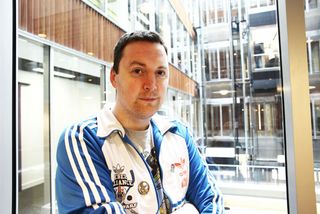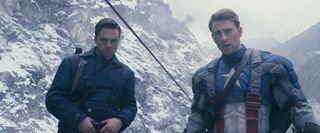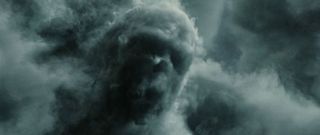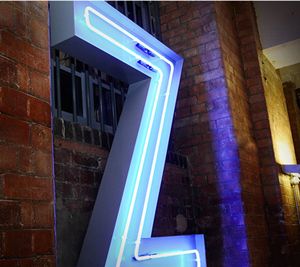This content has been brought to you in association with HP ZED, a 'pop up shop' for creatives in London's Soho from Monday 29 September to Friday 10 October 2014. Register for ZED today. Gavin Graham will be joining Phil Hurrell of Coffee&TV for a special session: Should you work for a big studio or boutique agency? - don't miss it!

One of the world's biggest animation and VFX studios, working at Double Negative is a dream job for 3D artists, and Gavin Graham is luckier than most: he's been there since he left university in 2000.
Graham started as studio support before beginning his artist career as Effects TD, creating snow for Bridget Jones’s Diary. Working up to lead artist, sequence lead, FX and CG supervisor, his film credits include The Sorcerer's Apprentice, Harry Potter and the Half-Blood Prince, Inkheart, Cloverfield and 2012.
After completing work as an FX lead on Captain America, Gavin moved over to co-manage the 3D department, which currently stands at over 600 staff. As co-head of 3D, he's overseen the likes of Inception, the Dark Knight Rises trilogy, Man of Steel, Thor: The Dark World and Hunger Games: Catching Fire.
In the run-up to his talk at HP ZED London, we caught up with him to chat about Hercules, managing artists and becoming a stay-at-home dad...
How has Double Negative changed since 2000?
The company is unrecognisable in some ways from when I started, but in many others is still the same old. Many of the 40 or so people that were here when I started are still around, or are bringing work to us, if they're now client side supervisors, and helping to create the same vibe.
It's funny to look back now at the various stages of our growth as people always had in their mind's eye an 'ideal size', which was usually how big it was when they first started.
Get the Creative Bloq Newsletter
Daily design news, reviews, how-tos and more, as picked by the editors.

When the company got to 180 people, I remember somebody important saying that we were now the optimum size: big enough to take on a few simultaneous projects, but still have the small company feel. Then somebody else gave the same sort of reasonings when we hit 300 for why we should be staying that size for some time to come!
So change is inevitable; the work always seems to increase scarily in complexity, and yet the team always comes up with the goods and so many people get to bring a lot to the table.
And more recently?
It's been great the last couple of years in the new London building, having everyone under one roof instead of scattered across Soho, which had made things feel fragmented for a little while.
It's great, too, now having international operations. I'm very proud thinking back to my first Singapore trip a few years ago just as we were starting to do hero work. And I'm proud of what's being produced there now – entire shows independently, at perfect 'dneg' quality – and am really excited to see what new changes our expansion into Vancouver will bring.
- Register today for Graham's talk on Should you work for a big studio or boutique agency? at HP ZED
What's the secret to supervising large teams of 3D artists?
Communication is key. I'd imagine this is true for any size of team. If all the artists are communicating effectively, they find it easier to understand the problems others might face, and might not do things that unintentionally make life harder for others.
You need constant back-and-forth, clear planning of how to execute a task, who's best to do it, and open discussions when missteps have caused additional unplanned work that get in the way of delivery. It's funny how much of our work has very little to do with computers at the end of the day!

Trust is important too, but unlike communication, it is certainly possible to have too much trust. As a supervisor it's important to strike the right balance between delegating and keeping involved hands-on with problems.
What's the main pitfall to avoid?
It's all too easy to get sucked into what seems like the biggest problem on a project that urgently needs resolving, only to find later on that you're being bitten much worse than should be expected by smaller things that should have gone just fine.
I've fallen victim to this in the distant past; leaving one task to get sorted out by somebody I had plenty of trust in while focussing too much of my own efforts on putting another fire out – only to realise that a whole new fire had been created because that person hadn't took everything required into account.
I suppose for both of those things, communication and trust, you're not going to have many issues if you have the best possible team of artists to work with. So the real secret is probably to make sure your large team is made up of superstars, and we do seem to have a lot of them these days.
What software's exciting you right now?
The most exciting area of software for me right now is the current renderer landscape. We're getting great results, and have delivered complex sequences in their entirety, with Mantra and Clarisse (along with our stalwart PRMan) and it makes for an exciting change from the quite static pipeline that we'd ran with for so many years.

It's great to see the artists getting their hands on these tools and picking the right tool for a certain type of problem, instead of being frustrated that the grass looks to be greener when rendered through something they can't get their hands on.
It looks like this landscape will carry on evolving at a rapid pace, and elements from the realtime/gaming world are bleeding across, so we're making sure we're set up for the future with the lighting and shading toolset we're developing.
What about hardware?
Hardware-wise, I love the Raspberry Pi. Not something we have much use for in production obviously, but I love what it's doing for the future.
It's great to think that the next generation is getting empowered to take control of computers and have the confidence to make things for themselves. Everything had got a bit too black box and closed off there in the mainstream for a while!
What did you learn from working on Hercules?
Hercules was the first time we'd done multiple complex CG creatures from scratch on a film since John Carter, and the biggest takeaway was a really satisfying payoff from all the work our Creature team had been doing in the meantime.
The short time it took for us to get the hero creatures to a good place surprised everyone - we were able to show near final progress on one of the hero creatures in particular while they were still shooting, allowing the onset creatives to get a firm understanding of exactly what would end up in the final frame.
Our new groom and crowd tools were related success stories, though some of the full-frame fur rendertimes were mind-boggling, and won't be forgotten anytime soon.
How did you swing six months off to be a stay-at-home dad?
Dneg has always been very good for recognising the importance of keeping the team happy, and have a good track record with flexible working time both for parents and people who have other reasons to request it. In the case of my firstborn, they were particularly happy for me to go off and take care of her because my wife also works at the company, so it did mean getting her back instead!
I'm very strongly of the opinion that dads should take an equal role in the sharing of parental responsibilities. I loved every minute of being able to dedicate myself full time to that role, and I'm eternally grateful that the bosses saw the importance of that when they didn't need to be so accommodating.
See Gavin speak at HP ZED!

Gavin Graham will be joining Phil Hurrell of Coffee&TV for a special session at HP ZED London on Thursday 2 October entitled Should you work for a big studio or boutique agency?
They'll examine whether a large or small studio is the best place to advance your career. It's a big decision to make, so make sure you get the expert advice on offer at this must-attend session. Register to attend here!

Thank you for reading 5 articles this month* Join now for unlimited access
Enjoy your first month for just £1 / $1 / €1
*Read 5 free articles per month without a subscription

Join now for unlimited access
Try first month for just £1 / $1 / €1
Tom May is an award-winning journalist and editor specialising in design, photography and technology. Author of the Amazon #1 bestseller Great TED Talks: Creativity, published by Pavilion Books, Tom was previously editor of Professional Photography magazine, associate editor at Creative Bloq, and deputy editor at net magazine. Today, he is a regular contributor to Creative Bloq and its sister sites Digital Camera World, T3.com and Tech Radar. He also writes for Creative Boom and works on content marketing projects.
